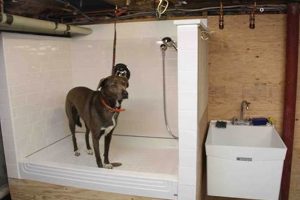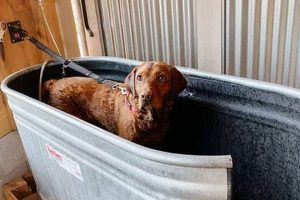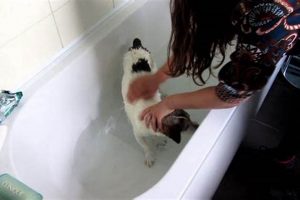A designated area designed and constructed by individuals for the purpose of washing canines at home constitutes a personalized grooming solution. These installations can range from simple repurposed laundry tubs to elaborate, custom-built structures incorporating features such as adjustable spray nozzles and elevated platforms. For instance, a homeowner might convert an unused corner of a garage into a dedicated space featuring a non-slip surface, drainage, and temperature-controlled water.
The creation of a specific area for canine hygiene offers several advantages. It reduces the mess associated with bathing pets indoors, potentially preventing damage to bathrooms or other areas. Furthermore, it can enhance the comfort and safety of the animal during the cleaning process, particularly for larger breeds or those with mobility issues. Historically, pet owners often resorted to outdoor washing, but climate control and convenience factors have driven a trend toward indoor, purpose-built areas.
Considerations when planning such a space include plumbing requirements, spatial limitations, the dog’s size and temperament, and the desired level of permanence. Subsequent sections will explore design options, material choices, and construction techniques for effectively implementing a bespoke pet hygiene area.
Construction and Maintenance Considerations
The following recommendations aim to assist in the design, construction, and upkeep of an effective and durable grooming facility.
Tip 1: Location Selection: Evaluate potential areas based on accessibility to plumbing, proximity to drainage, and suitability for containing water. Garages, mudrooms, or utility rooms frequently offer suitable infrastructure.
Tip 2: Material Durability: Utilize water-resistant and non-porous materials for surfaces exposed to moisture. Epoxy-based paints, sealed concrete, or fiberglass are viable options for floors and walls.
Tip 3: Drainage System Design: Ensure adequate drainage to prevent water accumulation and potential slip hazards. Incorporate a sloped floor directing water towards a drain equipped with a hair trap.
Tip 4: Elevated Platform Implementation: For medium to large breeds, consider an elevated platform to minimize back strain during grooming. The platform should be constructed with a non-slip surface and appropriate weight-bearing capacity.
Tip 5: Water Temperature Control: Install a mixing valve to regulate water temperature and prevent scalding. Ensure the valve meets plumbing codes and is accessible for adjustments.
Tip 6: Storage Optimization: Integrate storage solutions for grooming supplies, such as shampoos, towels, and brushes. Wall-mounted shelves or cabinets can maximize space efficiency.
Tip 7: Regular Maintenance Procedures: Implement a routine cleaning schedule to prevent the build-up of hair, soap residue, and bacteria. Disinfect surfaces regularly to maintain hygiene.
Adhering to these guidelines contributes to a more practical, safe, and hygienic environment, facilitating easier and more efficient canine grooming practices.
The subsequent section will address the customization possibilities of this installation to suit the specific needs of individual animals and owners.
1. Location Suitability
The selection of an appropriate location is a foundational element in the successful implementation of a do-it-yourself canine bathing area. This choice has direct ramifications for both the construction process and the long-term usability of the installation. Inadequate location assessment can lead to increased costs, compromised functionality, and potential safety hazards. For example, a location distant from existing plumbing infrastructure necessitates extensive and expensive pipework, potentially requiring professional assistance. Conversely, a location prone to drafts or temperature fluctuations could negatively impact the dog’s experience, increasing stress and potentially complicating the grooming process.
The physical attributes of a given space directly influence the design and materials employed. A small area necessitates space-saving design considerations, such as wall-mounted fixtures or collapsible platforms. Conversely, a larger area offers greater flexibility in layout and feature integration. Moreover, the existing flooring and wall materials dictate the extent of necessary modifications. For instance, a concrete floor in a garage may only require sealing, while a carpeted area necessitates complete floor replacement with a water-resistant material. Failure to account for these factors can result in a grooming area that is either impractical or prone to water damage and mold growth.
In summation, location suitability serves as a critical determinant of the practicality and longevity of a home-built canine bathing station. Prioritizing accessibility to essential utilities, adequate space, and appropriate environmental conditions is paramount. Neglecting these considerations can lead to increased costs, compromised functionality, and potential safety risks, ultimately undermining the effectiveness of the intended grooming solution.
2. Material Selection
The selection of materials is a critical determinant of the durability, hygiene, and overall effectiveness of a home canine washing facility. This aspect directly impacts the longevity of the structure and the safety and well-being of the animal during the bathing process. Inadequate material choices can lead to premature degradation, increased maintenance requirements, and potential health hazards for the dog. For example, using porous materials like untreated wood for the flooring can result in water absorption, fostering mold and bacterial growth, which can cause skin irritations or infections in the animal. The selection of non-slip surfaces is crucial for preventing injuries during bathing, particularly for older or less agile dogs. Furthermore, the chemical resistance of selected materials is important to withstand exposure to soaps, shampoos, and cleaning agents used during grooming.
Considerations for material selection should extend beyond immediate cost savings to encompass long-term performance and maintenance. While less expensive materials may seem appealing initially, they often require more frequent replacement or repair, leading to increased overall costs in the long run. For instance, using a low-grade sealant around plumbing fixtures may result in leaks and water damage, necessitating costly repairs to surrounding structures. The selection of durable, water-resistant, and chemically inert materials, such as epoxy-based paints, sealed concrete, or fiberglass, contributes to a more robust and hygienic bathing environment. Practical applications of this understanding can be observed in commercial dog grooming facilities, where durable and easily sanitized materials are commonly employed to maintain hygiene and prevent the spread of disease.
In conclusion, material selection is a pivotal aspect of constructing a functional and safe canine bathing station. Prioritizing durability, water resistance, chemical resistance, and ease of cleaning is essential for creating a hygienic and long-lasting structure. While initial costs may be higher, the long-term benefits of selecting appropriate materials outweigh the risks associated with inadequate choices. Addressing this critical aspect ensures the well-being of the animal and the longevity of the home grooming installation.
3. Plumbing Integration
Plumbing integration is a critical facet of establishing a functional at-home canine bathing area. It directly influences the usability, efficiency, and safety of the entire grooming process. Effective plumbing design and installation are essential for providing a consistent water supply, managing wastewater disposal, and controlling water temperature, all of which are fundamental to successful and comfortable pet hygiene practices.
- Water Supply Connections
Establishing a reliable water supply is paramount. This involves connecting the bathing area to the existing domestic water system, typically through hot and cold water lines. Proper connections ensure a consistent flow of water for washing. Incorrect installation can lead to pressure fluctuations, leaks, and potential damage to the existing plumbing infrastructure. Furthermore, backflow prevention devices are necessary to protect the potable water supply from contamination. For example, a failure to properly install a backflow preventer could allow contaminated water from the washing area to enter the household water system, posing a health risk.
- Drainage System
Efficient wastewater removal is equally critical. The drainage system must be adequately sized and connected to the existing plumbing network to prevent backups and overflows. A common error is connecting the drain to a system not designed to handle the volume of water generated during pet bathing, potentially leading to clogs and damage. The inclusion of a hair trap within the drainage system is essential to prevent hair from clogging the pipes. Failing to install an adequate hair trap can result in frequent clogs, requiring regular maintenance and potential plumbing repairs.
- Temperature Regulation
Water temperature control is vital for the comfort and safety of the animal. Installing a mixing valve allows for precise temperature adjustments, preventing scalding or discomfort from excessively cold water. Thermostatic mixing valves offer an added layer of safety by maintaining a consistent temperature regardless of fluctuations in water pressure or supply temperature. The absence of temperature regulation can lead to stress and potential injury to the pet during bathing. Consider the addition of a handheld sprayer with temperature control for greater control and efficiency during the bathing process.
- Fixture Selection and Installation
The selection and proper installation of appropriate plumbing fixtures, such as faucets and sprayers, directly impact the functionality and usability of the washing area. Durable and easy-to-clean fixtures are essential for long-term use. Improper installation of these fixtures can lead to leaks, reduced water pressure, and operational difficulties. Ergonomic design should also be a consideration, ensuring that the fixtures are easy to reach and operate, even with wet hands.
These facets of plumbing integration underscore its fundamental role in the design and implementation of a successful home canine bathing area. Addressing these considerations during the planning and construction phases ensures a safe, efficient, and comfortable grooming experience for both the pet and the owner, and also prevents costly plumbing repairs and water damage down the road. Properly executed plumbing contributes to the long-term usability and value of the grooming station, maximizing its benefits for pet hygiene and home maintenance.
4. Ergonomic Design
Ergonomic design is a critical, yet often overlooked, component in the creation of a functional and user-friendly canine bathing station. The primary objective is to minimize physical strain and maximize comfort for the individual performing the grooming tasks. In the context of a do-it-yourself project, neglecting ergonomic principles can result in discomfort, fatigue, and potential musculoskeletal injuries over time. For example, a bathing area constructed with a standard sink height may force the user to bend over excessively, leading to back pain. Similarly, insufficient space around the bathing area can restrict movement, causing awkward postures and increased physical exertion.
The application of ergonomic principles translates into several practical design considerations. An elevated platform for the dog reduces the need for bending, particularly beneficial for owners of larger breeds. The height of the washing station should be customized to the individual user’s height to maintain a neutral spine position. The placement of grooming supplies should be within easy reach to minimize reaching and twisting motions. Non-slip flooring is essential to prevent falls, which are a common hazard in wet environments. Furthermore, a handheld sprayer provides greater control and reduces the need to lift and manipulate heavy containers of water. Incorporating these elements into the design minimizes physical stress and improves the overall bathing experience.
In summary, integrating ergonomic design principles into the construction of a home canine bathing station is not merely an aesthetic consideration but a fundamental requirement for long-term usability and user well-being. Prioritizing comfort, minimizing physical strain, and optimizing workflow are essential. Failure to address these factors can diminish the benefits of having a dedicated grooming area and potentially lead to physical discomfort or injury. By carefully considering these aspects, the resulting canine bathing facility can be both functional and conducive to a positive grooming experience for both the owner and the animal.
5. Safety features
The integration of safety features within a DIY dog bath station is not merely an optional consideration but a critical requirement for mitigating potential hazards and ensuring the well-being of both the animal and the owner. The absence of such features can directly lead to injuries, stress, or even long-term health issues. Specifically, slippery surfaces pose a significant risk of falls for dogs, particularly senior animals or those with pre-existing musculoskeletal conditions. Sharp edges or protruding hardware can cause cuts or abrasions during bathing. Additionally, unrestrained animals may attempt to escape, potentially resulting in injury to themselves or the handler. Therefore, safety features are an indispensable component of any canine bathing area.
Practical applications of safety-conscious design are evident in several key areas. Non-slip surfaces, such as rubber mats or textured coatings, provide secure footing and minimize the risk of slips and falls. Rounded edges and covered hardware prevent accidental cuts or scratches. Adjustable restraints or tethers can help keep the animal safely positioned during the bathing process, particularly for dogs that are anxious or prone to moving around. Appropriate water temperature control is also paramount, as excessively hot water can cause burns. Elevated platforms, while improving ergonomics for the owner, must also be sturdy and stable to prevent collapse or tipping. For instance, a homemade platform constructed from untreated wood could splinter or buckle under the dog’s weight, creating a hazardous situation. Therefore, the careful selection of materials and construction techniques is crucial for ensuring the safety of the bathing area.
In conclusion, prioritizing safety features within a DIY dog bath station is essential for preventing injuries and promoting a positive grooming experience. Addressing potential hazards through careful design and construction minimizes risks for both the animal and the owner. The challenges associated with integrating these features often involve balancing cost considerations with the need for durable and reliable solutions. However, the long-term benefits of a safe and well-designed bathing area far outweigh the initial investment, ensuring the well-being of all involved and promoting consistent grooming practices.
6. Storage efficiency
Storage efficiency is a critical consideration in the design and implementation of a do-it-yourself canine bathing station. The limited space typically available for such installations necessitates careful planning to maximize the utility of the area. Inefficient storage solutions lead to clutter, impede movement, and ultimately detract from the convenience the station is intended to provide. A direct consequence of poor storage is the increased likelihood of tripping hazards, damage to grooming supplies, and the inefficient use of valuable space within the home. For instance, leaving shampoo bottles, brushes, and towels scattered around the bathing area creates an unsafe and disorganized environment, hindering the grooming process.
Effective storage solutions within the bathing area enhance its functionality and promote a more streamlined grooming routine. Wall-mounted shelves provide accessible storage for frequently used items such as shampoo, conditioner, and grooming tools, keeping them within reach while freeing up floor space. Cabinets or drawers offer concealed storage for less frequently used items or cleaning supplies, contributing to a tidier aesthetic. Hooks or racks can be utilized to hang towels and grooming apparel, allowing them to dry efficiently and preventing mildew growth. The integration of these storage solutions not only optimizes space utilization but also promotes a more organized and efficient grooming process. As a practical example, a cabinet beneath an elevated bathing tub could house all necessary bathing implements, concealing them when not in use and preserving the aesthetic integrity of the space.
In conclusion, storage efficiency is an indispensable component of a functional and well-designed DIY canine bathing station. Prioritizing thoughtful storage solutions enhances the overall utility of the area, promotes safety, and contributes to a more organized and efficient grooming routine. Overcoming the challenges associated with space limitations through clever design ensures that the bathing station fulfills its intended purpose without detracting from the overall usability of the home environment.
7. Maintenance ease
Maintenance ease is a critical factor directly influencing the long-term usability and cost-effectiveness of a do-it-yourself canine bathing station. A design that neglects maintenance considerations will inevitably lead to increased cleaning efforts, premature material degradation, and potential hygiene issues, undermining the benefits initially sought through the construction of a dedicated bathing area. The investment in time and resources to create such a station becomes significantly less valuable if ongoing maintenance proves overly burdensome or costly. For example, a bathing area constructed with porous materials and complex drainage systems will require significantly more effort to clean and maintain, increasing the risk of mold growth and unpleasant odors. This increased maintenance burden can discourage regular grooming, negatively impacting the animal’s hygiene and well-being.
The implementation of design choices that prioritize maintenance ease translates into several practical benefits. Smooth, non-porous surfaces, such as sealed concrete or fiberglass, are significantly easier to clean and disinfect compared to rough or absorbent materials. A simple, sloped floor design facilitates efficient water drainage, preventing the accumulation of standing water and associated hygiene issues. The incorporation of removable hair traps in the drainage system simplifies the removal of pet hair, preventing clogs and maintaining proper drainage function. The selection of durable, chemically resistant materials ensures that the bathing area can withstand regular cleaning with disinfectants without suffering damage or degradation. For example, using epoxy-based paints on walls and floors provides a seamless, non-porous surface that is resistant to water damage, stains, and harsh cleaning agents, minimizing the effort required for cleaning and maintenance.
In conclusion, maintenance ease is an indispensable element in the successful design and implementation of a DIY canine bathing station. Prioritizing materials, construction techniques, and design features that simplify cleaning and reduce maintenance requirements is essential for ensuring the long-term usability and cost-effectiveness of the installation. Overlooking this aspect can lead to increased cleaning efforts, hygiene problems, and premature material degradation, ultimately negating the benefits initially sought through the creation of a dedicated bathing area. A focus on maintenance ease contributes to a more hygienic, convenient, and sustainable solution for pet grooming.
Frequently Asked Questions
The following addresses common inquiries regarding the construction and utilization of at-home canine bathing areas. The information provided aims to offer clarity and practical guidance for those considering building such a facility.
Question 1: Is a permit required to construct a dog bath station?
Permitting requirements vary significantly depending on local regulations and the scope of the project. Alterations involving plumbing modifications typically necessitate permits. Contacting the local building department is crucial to ascertain specific requirements and avoid potential penalties.
Question 2: What is the recommended drain size for a dog bath station?
A minimum drain size of 2 inches is generally recommended to handle the volume of water and hair associated with dog bathing. Smaller drains are prone to clogging and may result in slow drainage, prolonging the bathing process.
Question 3: How can backflow prevention be ensured?
A backflow preventer, specifically designed for plumbing applications, must be installed on the water supply line to the bathing station. This device prevents contaminated water from flowing back into the potable water system, safeguarding the household water supply.
Question 4: What type of sealant is best for preventing leaks?
A high-quality silicone or polyurethane sealant, specifically formulated for wet environments, is recommended. These sealants provide a durable, waterproof barrier around plumbing fixtures and joints, preventing water intrusion and potential damage.
Question 5: How often should the hair trap be cleaned?
The hair trap should be inspected and cleaned regularly, ideally after each use. Frequent cleaning prevents clogs and maintains proper drainage flow. Neglecting this task can lead to significant plumbing issues.
Question 6: What is the best way to disinfect the dog bath station?
A diluted bleach solution (1 part bleach to 10 parts water) or a commercially available disinfectant specifically designed for pet areas is effective. Surfaces should be thoroughly cleaned, disinfected, and allowed to air dry to eliminate bacteria and prevent the spread of disease.
In summary, careful planning, adherence to local regulations, and the use of appropriate materials and techniques are essential for constructing a safe, functional, and long-lasting canine bathing area.
The subsequent section addresses the environmental considerations related to pet grooming at home.
DIY Dog Bath Station
The preceding sections have explored the multifaceted considerations surrounding the construction and maintenance of a dedicated canine bathing area. From location selection and material durability to plumbing integration, ergonomic design, and safety features, the importance of meticulous planning and execution has been consistently emphasized. The long-term benefits of such a facility, including enhanced pet hygiene, reduced mess, and improved owner convenience, hinge upon adherence to sound construction principles and a commitment to regular maintenance.
Ultimately, the success of a DIY dog bath station relies on a balance of practicality and attention to detail. Potential builders are encouraged to thoroughly research local regulations, carefully assess their spatial and budgetary constraints, and prioritize the safety and well-being of their animals. A well-designed and maintained facility not only simplifies pet grooming but also contributes to a more hygienic and harmonious home environment. The decision to invest in such a project represents a commitment to responsible pet ownership and a dedication to maintaining a clean and healthy living space.







